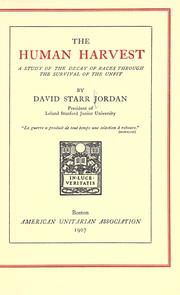Racial Hygiene and Social Degeneration
David Starr Jordan was concerned with society's overemphasis on implementing social hygiene measures without paying due attention to racial hygiene. He believed social hygiene was limited to improving the qualities of the pauper and socially degenerated whereas racial hygiene would improve the qualities of all men. Jordan's outlook on social degeneration is steeped in his training as a biologist. He believed that each law in animals can be extended upwards to the relationship between men and society, including laws on parasitism. Jordan defines social degeneration as the human manifestation of parasitism in which a person is afflicted with "the loss of complexity, the narrowing of the range of power and capabilities" (Kellog and Jordan 1900, p. 200). Degeneration is in direct opposition to intellectual and moral excellence. Jordan contends that "it has been shown that a large part of the criminality and pauperism among men is hereditary, due to the survival of the tendency toward living at the expense of others" (Kellog and Jordan 1900, p. 200). The role of eugenics was to reconcile social development with racial progress. As a part of this reconciliation process, he firmly believed that people should more heavily scrutinize the act of giving to charity. He claimed that human ways of careless charity propagate social degenerates. Charity sole emphasis on social development seemed retroactive to Jordan.
The Human Harvest

The Human Harvest was first published in 1907. The entirety of the text can be found online here. The text is one of two substantial published works that deal directly with eugenics. However, despite Jordan's significant background in science the work is less scientific and more focused on narratives and parables to demonstrate the case of Human Heredity in terms of eugenics.
The book begins with an introductory note, "How long will the Republic endure? [...] The Republic shall endure so long as the human harvest is good, so long as the movement of history, the progress of science and industry, leaves for the future the best and not the worst of each generation" (1. Human Harvest Intro.) This sets the tone for the argument that unfolds throughout the narrative finally leading to a discussion of the human harvest.
Jordan starts with a discussion of horse breeding. It is evident that the story is meant to teach the reader a lesson because he begins with "Once there was a man, strong, wealthy, and patient, who dreamed of a finer type of horse than ever had existed" (1. p.14.) In this parable, the horses represent Mankind in general. Jordan goes on to include the effects of variation, segregation, heredity, and selection. He personifies these
The book begins with an introductory note, "How long will the Republic endure? [...] The Republic shall endure so long as the human harvest is good, so long as the movement of history, the progress of science and industry, leaves for the future the best and not the worst of each generation" (1. Human Harvest Intro.) This sets the tone for the argument that unfolds throughout the narrative finally leading to a discussion of the human harvest.
Jordan starts with a discussion of horse breeding. It is evident that the story is meant to teach the reader a lesson because he begins with "Once there was a man, strong, wealthy, and patient, who dreamed of a finer type of horse than ever had existed" (1. p.14.) In this parable, the horses represent Mankind in general. Jordan goes on to include the effects of variation, segregation, heredity, and selection. He personifies these
The Blood of the Nation

Paragraph.
